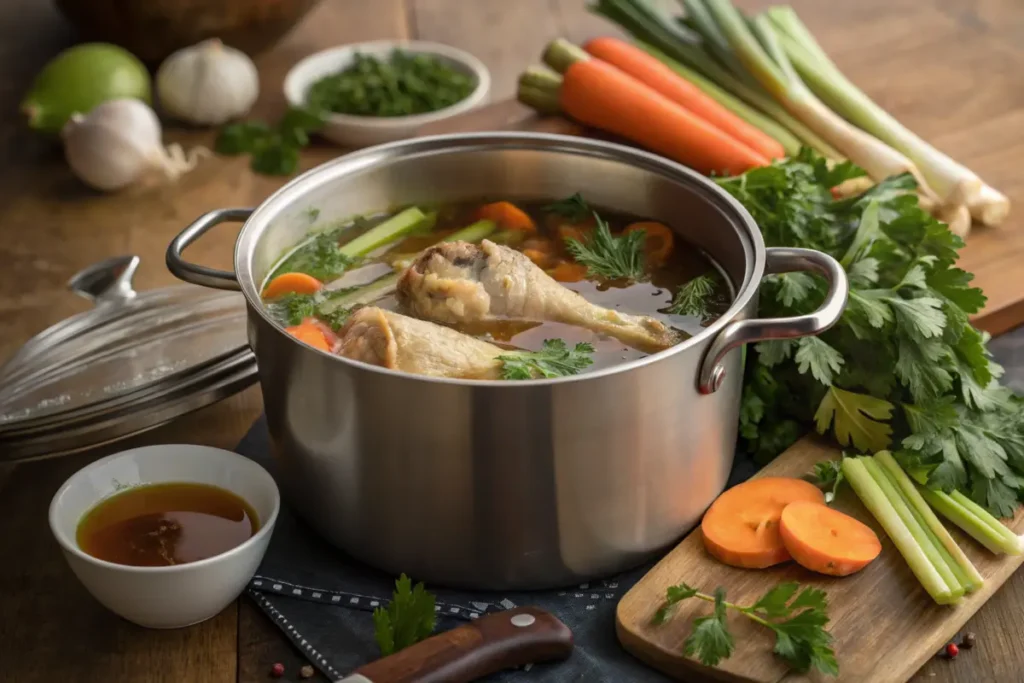When it comes to cooking, terms like broth, stock, and bone broth are often used interchangeably, but they’re not the same thing. Each has unique characteristics, ingredients, and uses in the kitchen. Understanding these differences can elevate your culinary skills, helping you make the perfect soup, sauce, or stew. In this article, we’ll break down what’s the difference between chicken broth, stock, and bone broth? From their preparation and ingredients to their nutritional profiles and applications, we’ll leave no stone unturned. Let’s dive into the delicious world of broths and stocks!
Introduction to Broth, Stock, and Bone Broth
What are Chicken Broth, Stock, and Bone Broth?
Chicken broth, stock, and bone broth are all liquid gold for home cooks and chefs alike. While they may seem similar at first glance, their differences lie in the way they’re made, the ingredients used, and how they’re applied in cooking. At its core, chicken broth is a light and flavorful liquid made by simmering meat with vegetables. Stock, on the other hand, is heartier, simmered with bones to extract gelatin and deepen the flavor. Bone broth takes it a step further, simmering bones for hours (or even days) to create a nutrient-rich elixir.
Why Understanding the Differences Matters
Choosing the right liquid can make or break a recipe. Imagine making a delicate soup with the thick, gelatinous stock—it might overwhelm the dish! Similarly, using light broth instead of rich bone broth in a hearty stew could leave it tasting bland. Knowing the distinctions ensures you choose the best option for the job. It’s also about health: bone broth, with its high collagen content, is touted for its gut-healing properties, while broth is prized for its lightness and versatility.
From soups to sauces and everything in between, each of these liquids has its place in the kitchen. As we explore each in detail, you’ll discover which one to reach for depending on your culinary goals.
Chicken Broth Explained
Definition and Preparation of Chicken Broth
Chicken broth is a light and flavorful liquid created by simmering meat, often with aromatics like onions, carrots, celery, and herbs. Unlike stock, it doesn’t rely on bones as the main ingredient. This simplicity makes chicken broth a quick and versatile base for soups and other dishes. The preparation typically takes about 1-2 hours, ensuring the flavors remain subtle and not overpowering.
Nutritional Profile of Chicken Broth
Chicken broth shines for its low calorie and fat content, making it a go-to choice for lighter meals. It’s also rich in vitamins like B6 and minerals such as potassium, which support overall health. However, it lacks the collagen and gelatin that bone broth offers, giving it a thinner texture and less robust nutritional benefits.
Common Uses of Chicken Broth in Cooking
From soups to risottos, chicken broth is a culinary staple. Its light flavor complements a variety of dishes without overwhelming the palate. It’s also an excellent option for poaching vegetables or proteins, adding a hint of savoriness. If you’re looking for a versatile liquid that’s easy to work with, chicken broth is your best bet.
For a deeper dive into chicken recipes, check out these creative uses for chicken and potatoes.
Chicken Stock Demystified
What is Chicken Stock?
Chicken stock is richer and more robust than chicken broth, thanks to its base of simmered bones. The marrow and connective tissues in the bones break down during cooking, creating a thicker, gelatin-rich liquid. Stock is typically simmered for 4-6 hours, which allows its full flavors to develop.
How Chicken Stock is Made
The process begins with roasted chicken bones for enhanced flavor, paired with the classic aromatic trio—onions, carrots, and celery. Herbs like thyme or parsley are often added, creating a deeply flavorful liquid. The longer cooking time extracts more nutrients and creates a slightly thicker consistency than broth.
Key Features that Set Chicken Stock Apart from Broth
The main differences between chicken stock and broth lie in their preparation and applications. Stock has a more intense flavor and a gelatinous texture when cooled, thanks to the collagen extracted from the bones. These qualities make it ideal for recipes where a rich, velvety base is needed, such as gravies or sauces.
By knowing what’s the difference between chicken broth, stock, and bone broth, you can tailor your choice to suit the dish you’re preparing. For example, stock adds depth to stews and braises, enhancing the overall taste.
Looking for stock-friendly recipes? Consider exploring slow-cooked meals that highlight chicken and broth combinations.
Bone Broth Unveiled

What Makes Bone Broth Unique?
Bone broth stands out for its deep, savory flavor and extensive cooking process. Unlike broth or stock, it is made by simmering bones—often with a little meat still attached—for a much longer period, typically 12-24 hours or more. This long cooking time allows the bones to release collagen, minerals, and nutrients, creating a nutrient-dense liquid. It’s also flavored with aromatics and sometimes vinegar, which helps extract minerals from the bones.
The Long Cooking Process of Bone Broth
The extended cooking process of bone broth is what sets it apart. As the bones simmer, gelatin from cartilage is released, giving bone broth its characteristic thickness and a slightly sticky texture when cooled. The addition of vegetables and herbs adds complexity to the flavor, making it a culinary and nutritional powerhouse.
Health Benefits Attributed to Bone Broth
Bone broth is often celebrated for its health benefits. The collagen and gelatin it contains are great for joint health and skin elasticity, while the minerals can help strengthen bones. It’s also a go-to for supporting gut health, thanks to its easy digestibility and gut-soothing properties.
If you’re curious about the best bones to use for making bone broth at home, check out this guide on chicken bone broth.
Key Differences Between Broth, Stock, and Bone Broth
Ingredients: What Goes Into Each?
When asking what’s the difference between chicken broth, stock, and bone broth?, ingredients are a key factor. Broth relies on meat, stock focuses on bones, and bone broth uses both but emphasizes a longer cooking process to extract nutrients. Vinegar is often added to bone broth, which isn’t common in stock or broth, to draw out more minerals.
Cooking Time: Quick vs. Prolonged Processes
Cooking times vary widely among these three kitchen staples. Chicken broth is the quickest, typically ready in 1-2 hours. Stock takes longer, around 4-6 hours, to extract gelatin from the bones. Bone broth, however, requires a day or more, making it a commitment—but one that’s worth it for its rich flavor and health benefits.
Texture and Flavor Differences
Broth is light and thin, perfect for sipping or using in delicate recipes. Stock is thicker, thanks to the gelatin from bones, and provides a rich, savory base for hearty dishes. Bone broth is the thickest of all and has a robust flavor that makes it an excellent standalone drink or soup base.
Nutritional Variances: Which is Healthiest?
Each liquid offers distinct nutritional advantages. Broth is low in calories and suitable for lighter meals. Stock adds some nutritional heft with its collagen content, while bone broth takes the crown for its high levels of collagen, minerals, and gut-friendly properties. It’s a matter of choosing the right option for your needs and goals.
For more tips on using these liquids in your recipes, explore our complete guide to chicken and bone broth cooking.
Practical Applications in Cooking

When to Use Broth, Stock, or Bone Broth
Knowing what’s the difference between chicken broth, stock, and bone broth? can transform your cooking. Chicken broth is best for recipes that need a light base, like clear soups or poaching vegetables. It blends seamlessly with ingredients without overshadowing them. Stock, with its richer flavor, is ideal for stews, sauces, and gravies that benefit from its robust taste. Bone broth shines as a stand-alone drink or a base for nutrient-packed soups.
Choosing the right one depends on the dish’s complexity. For example, broth is perfect for a simple chicken noodle soup, while stock can elevate a creamy risotto. If health benefits are your goal, bone broth’s collagen and minerals make it a top choice.
Substituting One for Another: Does it Work?
In a pinch, you can substitute broth, stock, or bone broth for one another, but the results may vary. Using stock instead of broth will deepen the flavor of your dish, while bone broth can make it thicker and more nutrient-dense. On the other hand, replacing stock or bone broth with broth might lead to a less intense taste.
If you’re crafting recipes that call for these staples, understanding their nuances ensures you make the best substitutions. For instance, in a hearty beef stew, bone broth can be a better substitute for stock than broth, as it provides the necessary depth and body.
For more versatile recipe ideas using chicken broth and stock, explore this recipe guide on combining chicken and potatoes.
FAQs on Chicken Broth, Stock, and Bone Broth
What’s the Main Difference Between Stock and Broth?
The primary difference lies in their ingredients and cooking time. Broth is made from meat and vegetables, creating a light, flavorful liquid. Stock, on the other hand, uses bones, producing a thicker, gelatin-rich base with a deeper flavor.
Is Bone Broth Healthier Than Chicken Broth?
Bone broth is often considered healthier due to its high collagen content and minerals. These nutrients support joint health, skin elasticity, and digestion. However, chicken broth still has its place for those seeking a lighter, low-calorie option.
Can I Use Bone Broth in Place of Stock?
Yes, bone broth can substitute for stock, but it will create a richer and thicker dish. This is particularly useful for soups, stews, and sauces where a nutrient boost is desired.
How to Store Broth, Stock, and Bone Broth Safely?
All three should be stored in airtight containers in the fridge for up to 4 days or frozen for longer storage. Freezing in portion sizes, like in ice cube trays, ensures you always have the right amount for your recipes.
For more answers to your cooking questions, don’t forget to check out our other guides and tips on recipe creation.
Tips for Making Chicken Broth, Stock, and Bone Broth at Home
Essential Ingredients for Each
To master homemade chicken broth, stock, or bone broth, the right ingredients are essential. For broth, focus on chicken meat, a mix of vegetables like onions, carrots, and celery, and herbs for a light, flavorful base. Stock requires roasted bones, which release collagen during cooking, alongside similar aromatics. Bone broth goes a step further, using bones with a bit of meat, a splash of vinegar to draw out minerals, and extended cooking time for maximum nutrients.
Key Techniques for Best Results
The techniques differ slightly, depending on your desired outcome. For chicken broth, a quick simmer (1-2 hours) is all you need. Stock benefits from roasting the bones first and simmering them longer, around 4-6 hours. Bone broth requires patience, simmering for 12-24 hours or more to extract all its nutritional goodness.
Skimming impurities and fat from the surface ensures a clear, clean-tasting liquid. And remember, the longer the cooking time, the richer the flavor and thicker the consistency.
To explore creative ways to use your homemade broths, try pairing them with hearty dishes. For example, chicken stock can enhance recipes like risottos or pot pies.
How to Store and Reuse Broth, Stock, and Bone Broth
Storage Tips for Maximum Freshness
Storing these culinary staples is simple when done correctly. For short-term storage, keep them in airtight containers in the fridge for up to 4 days. To extend their shelf life, freeze them in portioned amounts. Ice cube trays are a fantastic tool for freezing small portions, ensuring you only thaw what you need.
Reusing and Repurposing Leftovers
Don’t let leftovers go to waste! Chicken broth can be used to deglaze pans or add a savory touch to rice or quinoa. Stock is excellent for thickening soups or making sauces, while bone broth can be sipped as a warm, nourishing drink.
If you’re curious about how different recipes use these bases, consider trying your hand at creative chicken and broth combinations. Each offers new ways to explore what’s the difference between chicken broth, stock, and bone broth in practice.
Conclusion
Understanding what’s the difference between chicken broth, stock, and bone broth is key to making informed decisions in the kitchen. Each serves a unique purpose, from the light and versatile chicken broth to the rich and flavorful stock, and finally to the nutrient-packed bone broth. By knowing their differences in ingredients, preparation, and uses, you can elevate your cooking and create dishes with the perfect flavor and texture.
Whether you’re whipping up a quick soup, enhancing a sauce, or seeking a healthful drink, there’s a role for each of these staples in your culinary repertoire. Don’t be afraid to experiment and tailor them to your needs—each offers endless possibilities to explore.
Ready to start cooking? Gather your ingredients and put your newfound knowledge to the test. For more tips and recipes, explore the diverse range of guides at Recipe Foodies. Happy cooking!

